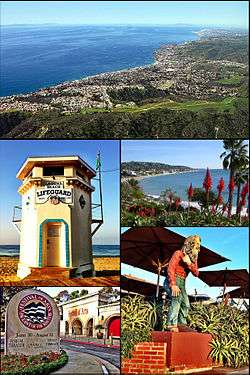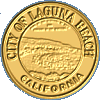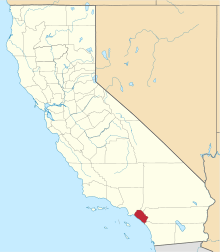Laguna Beach, California
| Laguna Beach, California | ||
|---|---|---|
| City | ||
|
Images from top, left to right: Laguna Beach coastline, Lifeguard Tower, view from Heisler Park, Festival of the Arts, and statue of Town Greeter Eiler Larsen. | ||
| ||
 Location within California and Orange County | ||
| Coordinates: 33°31′53″N 117°46′9″W / 33.53139°N 117.76917°WCoordinates: 33°31′53″N 117°46′9″W / 33.53139°N 117.76917°W | ||
| Country | United States | |
| State | California | |
| County | Orange | |
| Founded (post office) | 1887 | |
| Incorporated (city) | June 29, 1927[1] | |
| Government | ||
| • Type | Council-manager[2] | |
| Area[3] | ||
| • Total | 9.821 sq mi (25.435 km2) | |
| • Land | 8.850 sq mi (22.921 km2) | |
| • Water | 0.971 sq mi (2.515 km2) 9.89% | |
| Elevation[4] | 20 ft (6 m) | |
| Population (April 1, 2010)[5] | ||
| • Total | 22,723 | |
| • Estimate (2013)[5] | 23,250 | |
| • Density | 2,300/sq mi (890/km2) | |
| Time zone | Pacific (UTC−8) | |
| • Summer (DST) | PDT (UTC−7) | |
| ZIP codes | 92651, 92652 | |
| Area code | 949 | |
| FIPS code | 06-39178 | |
| GNIS feature IDs | 1660874, 2411595 | |
| Website |
lagunabeachcity | |
Laguna Beach is a seaside resort city located in southern Orange County, California, in the United States. It is known for a mild year-round climate, scenic coves, environmental preservation, and artist community. The population in the 2010 census was 22,723.
Historically a territory of Paleoindians, the Tongva people and then Mexico, the location became part of the United States following the Mexican–American War. Laguna Beach was settled in the 1870s, officially founded in 1887 and, in 1927 its current government was incorporated as a city. In 1944, the city adopted a council-manager form for its government. The city has remained relatively isolated from urban encroachment by its surrounding hills, limited highway access, and a dedicated greenbelt. The Laguna Beach coastline is protected by 5.88 miles (9.46 km) of state marine reserve and an additional 1.21 miles (1.95 km) of state conservation area.[6]
Tourism is the primary industry with an estimated three million people visiting the community annually.[7] Annual large events include the Pageant of the Masters, Festival of the Arts, Sawdust Art Festival, Art-A-Fair, Bluewater Music Festival, and Kelpfest.
History
Laguna Beach was the habitation site of a prehistoric paleoindian civilization.[8] In 1933, the first fossilized skull of a paleoindian found in California was uncovered during construction on St. Ann's Drive.[9] Known as "Laguna Woman", the skull originally was radiocarbon dated to more than 17,000 BP, however, revised measurements suggest it originated during the Holocene era 11,700 years before present.[10] Subsequent research has found several prehistoric encampment sites in the area.[11]
Historically, the indigenous people of the Laguna Beach area were the Tongva. Aliso Creek served as a territorial boundary between Gabrieleno and Acjachemen groups, or Juanenos, named by Spanish missionaries who first encountered them in the 1500s.[12][13] The area of Laguna Canyon was named on an 1841 Mexican land grant map as, Cañada de las Lagunas (English:Glen of the Lagoons).[14] After the Mexican-American War ended in 1848, the area of Alta California was ceded to the United States. The treaty provided that Mexican land grants be honored and Rancho San Joaquin, which included north Laguna Beach, was granted to José Antonio Andres Sepúlveda. Following a drought in 1864, Sepúlveda sold the property to James Irvine.[15] The majority of Laguna Beach was one of the few parcels of coastal land in Southern California that never was included in any Mexican land grant.[15]
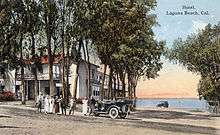

Settlers arrived after the American Civil War. They were encouraged by the Homestead Act and Timber Culture Act, which granted up to 160 acres of land to a homesteader who would plant at least 40 acres of trees. In Laguna Beach, settlers planted groves of eucalyptus trees.[16] In 1871, the first permanent homestead in the area was occupied by the George and Sarah Thurston family of Utah on 152 acres of Aliso Creek Canyon.[17][18] In 1876, the brothers William and Lorenzo Nathan "Nate" Brooks purchased tracts of land in Bluebird Canyon at present-day Diamond Street. They subdivided their land, built homes and initiated the small community of Arch Beach.[19] In his book, History of Orange County, California (1921), Samuel Armor cited permanent homestead of Nate Brooks as the beginning of the modern day town and described Brooks as the "Father of Laguna Beach."[20]
The community in Laguna Canyon and around the main beach expanded during the 1880s. The city officially founded a post office in 1887 under the name Lagona (sic), but the postmaster in 1904, Nicholas Isch, successfully petitioned for a name correction to Laguna Beach.[21] By then Laguna Beach already had developed into a tourist destination.[22] Hubbard Goff built a large hotel at Arch Beach in 1886, which later was moved and added to Joseph Yoch's Laguna Beach Hotel built in 1888 on the main beach.[23] Visitors from local cities pitched tents on the beaches for vacation during the warm summers.[24]
The scenic beauty of the isolated coastline and hills attracted plein-air painters in the early 1900s. William Wendt, Frank Cuprien, and Edgar Payne among others settled there and formed the Laguna Beach Art Association. The first art gallery opened in 1918 and later became the Laguna Beach Art Museum.[25] Precursors to The Festival of the Arts and the Pageant of the Masters began in 1921, and eventually were established in their present day form by Roy Ropp in 1936.[26] Due to its proximity to Hollywood, Laguna also became a favorite filming location. Starting in 1913, dozens of silent films were made at local coves with Harold Lloyd, Mary Pickford, Douglas Fairbanks, Jr., and others. Actors and film crews stayed during long production shoots at the Arch Beach Tavern on the hillside above Moss Street.[27]
The arrival of painters, photographers, filmmakers, and writers established Laguna Beach as a noted artist community.[24] Although there only were approximately 300 residents in 1920, a large proportion of them worked in creative fields.[28] The small town remained isolated until 1926 because the long winding Laguna Canyon road served as the only access.[28] With the completion of the Pacific Coast Highway in 1926, a population boom was expected. In order to protect the small town atmosphere of the art colony, residents who called themselves "Lagunatics" pushed for incorporation.[28] The municipal government for Laguna Beach incorporated as a city on June 29, 1927.[29] The city experienced steady population growth since that time, rising from 1900 residents in 1927 to more than 10,000 in 1962, and becoming four times larger in area.[28]
Many creative, bohemian, and wealthy people have made Laguna Beach their home. They have added to the local culture by providing a theme for the small town. The adventurer Richard Halliburton built his Hangover House on the slopes of South Laguna. Hildegarde Hawthorne, granddaughter of the novelist Nathaniel Hawthorne, described Laguna "as a child of that deathless search, particularly by persons who devote their lives to painting or writing, or for some place where beauty and cheapness and a trifle of remoteness hobnob together in a delightful companionship."[30]
Laguna Beach was the southern California epicenter of the 'alternative' hippy culture in the late 1960s and early 1970s.[31] In early 1967, John Griggs and other founding members of the Brotherhood of Eternal Love relocated from Modjeska Canyon to the Woodland Drive neighborhood of Laguna Beach, which they later re-christened "Dodge City".[31] Timothy Leary lived in a beach house on Gaviota Drive.[32]
Geography
According to the United States Census Bureau, the city of Laguna Beach has a total area of 25.4 km2 (9.8 sq mi), of which 22.9 km2 (8.8 sq mi) is land and 2.5 km2 (0.97 sq mi). Its coastline is 7 mi (11 km) long and includes 27 beaches and coves.[33] It is bordered by the Pacific Ocean on the southwest, Crystal Cove State Park on the northwest, Laguna Woods on the northeast, Aliso Viejo and Laguna Niguel on the east, and Dana Point on the southeast.
The land in and around Laguna Beach rises quickly from the shoreline into the hills and canyons of the San Joaquin Hills. The town's highest point, at an elevation of 1,007 feet (307 m), is Temple Hill in the Top of the World neighborhood.[34] Because of its hilly topography and surrounding parklands, there are few roads into or out of town; only the Coast Highway connecting to Newport Beach to the northwest and to Dana Point to the south, and State Route 133 crossing the hills in a northeastern direction through Laguna Canyon. Parts of Laguna Beach border the Aliso/Wood Canyons Regional Park.
The natural landscape of beaches, rocky bluffs and craggy canyons have been noted as sources of inspiration for Plein air painters who have settled in the Laguna Beach since the early 1900s.[35][36] The hills also are known internationally for mountain biking.[37] Laguna Coast Wilderness Park[38] is a 7,000-acre (2,800 ha) wilderness area in the hills surrounding Laguna Beach. This park features coastal canyons, ridgeline views and the only natural lakes in Orange County.
Climate
Laguna Beach has a mild Mediterranean climate with abundant sunshine all year. The average daily high temperature ranges from 68 °F in January to 80 °F in August. Mean annual precipitation is relatively low at 13.56 inches. The average ocean water temperatures range from about 59 °F in February to 68 °F in August; with early to mid-September water temperatures often peaking at about 72 °F.[39] However, the ocean surface temperatures along the beaches of Laguna Beach may vary by several degrees from the average, dependent upon offshore winds, air temperature, and sunshine.[39]
| Climate data for Laguna Beach, California | |||||||||||||
|---|---|---|---|---|---|---|---|---|---|---|---|---|---|
| Month | Jan | Feb | Mar | Apr | May | Jun | Jul | Aug | Sep | Oct | Nov | Dec | Year |
| Record high °F (°C) | 89 (32) |
92 (33) |
92 (33) |
97 (36) |
100 (38) |
102 (39) |
104 (40) |
100 (38) |
108 (42) |
104 (40) |
100 (38) |
90 (32) |
108 (42) |
| Average high °F (°C) | 68 (20) |
68 (20) |
69 (21) |
72 (22) |
73 (23) |
75 (24) |
79 (26) |
80 (27) |
80 (27) |
77 (25) |
72 (22) |
67 (19) |
73.3 (23) |
| Average low °F (°C) | 44 (7) |
45 (7) |
47 (8) |
50 (10) |
54 (12) |
58 (14) |
61 (16) |
60 (16) |
59 (15) |
54 (12) |
48 (9) |
43 (6) |
51.9 (11) |
| Record low °F (°C) | 21 (−6) |
27 (−3) |
28 (−2) |
31 (−1) |
33 (1) |
37 (3) |
30 (−1) |
38 (3) |
40 (4) |
33 (1) |
28 (−2) |
24 (−4) |
21 (−6) |
| Average precipitation inches (mm) | 2.75 (69.9) |
2.96 (75.2) |
2.58 (65.5) |
0.84 (21.3) |
0.25 (6.4) |
0.13 (3.3) |
0.04 (1) |
0.12 (3) |
0.35 (8.9) |
0.47 (11.9) |
1.23 (31.2) |
1.84 (46.7) |
13.56 (344.4) |
| Source: The Weather Channel[40] | |||||||||||||
Demographics
| Historical population | |||
|---|---|---|---|
| Census | Pop. | %± | |
| 1930 | 1,981 | — | |
| 1940 | 4,460 | 125.1% | |
| 1950 | 6,661 | 49.3% | |
| 1960 | 9,288 | 39.4% | |
| 1970 | 14,550 | 56.7% | |
| 1980 | 17,858 | 22.7% | |
| 1990 | 23,170 | 29.7% | |
| 2000 | 23,727 | 2.4% | |
| 2010 | 22,723 | −4.2% | |
| Est. 2015 | 23,365 | [41] | 2.8% |
2010
The 2010 United States Census[43] reported that 22,723 people, 10,821 households, and 5,791 families resided in the city. The population density was 2,313.8 people per square mile (893.4/km²). There were 12,923 housing units at an average density of 1,315.9 per square mile (508.1/km²). The racial makeup of Laguna Beach was 90.9% White (85.7% Non-Hispanic White), 0.8% African American, 0.3% Native American, 3.6% Asian, 0.1% Pacific Islander, 1.5% from other races, and 2.9% from two or more races.[44] 7.3% of the population was Hispanic or Latino of any race.[44]
The Census reported that 99.6% of the population lived in households and 0.4% lived in non-institutionalized group quarters. There were 10,821 households out of which 20.1% had children under the age of 18 living in them, 43.6% were opposite-sex married couples living together, 6.3% had a female householder with no husband present, and 3.6% had a male householder with no wife present. 5.2% of households were unmarried opposite-sex partnerships and 2.8% were same-sex married couples or partnerships. 35.2% of households were made up of individuals and 10.4% had someone living alone who was 65 years of age or older. The average household size was 2.09. The average family size was 2.72.
The population was spread out with 16.1% under the age of 18, 4.8% aged 18 to 24, 23.4% aged 25 to 44, 37.4% aged 45 to 64, and 18.3% who were 65 years of age or older. The median age was 48.3 years. For every 100 females there were 100.6 males. For every 100 females age 18 and over, there were 99.8 males.
There were 12,923 housing units of which 60.0% were owner-occupied and 40.0% were occupied by renters. The homeowner vacancy rate was 1.7%; the rental vacancy rate was 7.7%. 64.6% of the population lived in owner-occupied housing units and 35.0% lived in rental housing units.
During 2009–2013, Laguna Beach had a median household income of $94,325, with 6.3% of the population living below the federal poverty line.[45]
2000
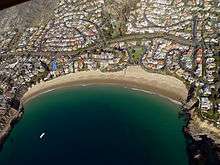

As of the census[46] of 2000, there were 23,727 people, 11,511 households, and 5,778 families residing in the city. The population density was 1,035.1/km2 (3,000/sq mi). There were 12,965 housing units at an average density of 565.6/km2 (1,000/sq mi). The racial makeup of the city was 91.99% White, 0.80% African American, 0.36% Native American, 2.08% Asian, 0.08% Pacific Islander, 2.21% from other races, and 2.47% from two or more races. Hispanic or Latino of any race were 6.62% of the population.
There were 11,511 households out of which 18.5% had children under the age of 18 living with them, 40.9% were married couples living together, 6.3% had a female householder with no husband present, and 49.8% were non-families. 36.7% of all households were made up of individuals and 8.1% had someone living alone who was 65 years of age or older. The average household size was 2.05 and the average family size was 2.69.
In the city the population was spread out with 15.8% under the age of 18, 4.2% from 18 to 24, 32.9% from 25 to 44, 33.9% from 45 to 64, and 13.3% who were 65 years of age or older. The median age was 43 years. For every 100 females there were 103.7 males. For every 100 females age 18 and over, there were 104.0 males.
According to a 2007 estimate, the median income for a household in the city was $90,017, and the median income for a family was $146,562.[47] Males had a median income of $66,221 versus $46,138 for females. The per capita income for the city was $58,732. About 2.8% of families and 5.1% of the population were below the poverty line, including 4.7% of those under age 18 and 4.3% of those age 65 or over.
Arts, music, and culture
The Laguna Art Museum is rooted in the development of Laguna Beach as an art community with the creation of the Laguna Beach Art Association in 1918.[48] Located beside the main beach, the museum focuses on the art of California. The Pageant of the Masters, founded in 1935, is held annually during the summer months. The unique show presents recreations of famous artworks using real people as models. Community organizations also host several long-running art festivals during the summer season.[49]

The Festival of Arts, originated in the 1930s and showcases juried works by local artists. The Sawdust Art Festival was founded in 1965 as a counterculture alternative to the Festival of the Arts. It exhibits non-juried crafts and arts on a dedicated three-acre site. The Art-A-Fair began in 1966, built an exhibition site in 1977 and exhibits juried works of 125 artists from outside the area.[50]
The Laguna Playhouse, founded in 1920, is noted as the "oldest continuously running theatre on the west coast".[51] The playhouse provides professional stage productions in its 420-seat Moulton Theater, as well as performances by the Laguna Playhouse Youth Theatre program. The Irvine Bowl is a 2600-seat amphitheater used for the Pageant of the Masters program and for occasional concerts.
The Laguna Beach Plein Air Painting Invitational is held annually in October.[52] Some of North America's plein air landscape painters are invited to participate in the week-long events including public paint outs, artist meet and greets, and educational activities.
The Laguna Beach Arts Commission sponsors a weekly Summer Concert in the Park series at Bluebird Park and Heisler Park. The Laguna Beach Chamber Music Society holds an annual chamber music festival during the winter season. Laguna is also home to the annual Bluewater Music Festival, and Kelpfest held on Earth Day, to raise awareness of the importance that kelp plays in ocean habitat.[53]
Surf culture and sports
Laguna has a rich surf history. The Brooks Street Surfing Classic is the oldest continuing surf contest in the world.[54] Begun in 1955, the competition is held only when peak swell conditions occur during a four-month-long window in the summer. Participation is open only to Laguna Beach residents.[55] Notable participants have included surfing greats such as Hobie Alter, Mickey Munoz, and Tom Morey, to name a few.
Started in 1976, the 'Vic' Skimboarding World Championship is held at Aliso Beach in Laguna Beach, and is the longest running skim boarding contest on the pro circuit.[56]
The Laguna Open Volleyball Tournament first started in 1955 and is the oldest continuously run volleyball tournament in the world. Local players such as gold medalist Dain Blanton and others have gone on to become professional beach athlete.
Laguna's foothill trails are known internationally for mountain biking.[37] Mountain bike hall of fame legend, Hans Rey makes his home in Laguna Beach, as do the Rads,[57] pioneers of mountain biking going back to the 70s.
The U.S. Open for Lawnbowling is held annually, at the lawn bowling field at Heisler Park.[58]
Government
Laguna Beach was first settled in the 1870s, but was founded officially in 1887 and, in 1927 it incorporated as a city. Beginning in 1944, a council-manager form of government was adopted.[2] Residents of Laguna Beach elect five non-partisan council members who serve four-year staggered terms, with elections occurring every two years. The position of mayor is non-elected and chosen annually among the members of the city council. The council serves to pass ordinances, approve a budget, and hire the city manager and city attorney. The city manager oversees administrative operations and the appointment of department heads. In 2011, John Pietig was hired as city manager following the retirement of his boss, Ken Frank who, after 31 years, was one of the longest-serving city managers in Orange County history.
The city clerk and city treasurer are elected by popular vote and serve four-year terms.[59][60]
County, state, and federal representation
Laguna Beach is located in the fifth district of the Orange County Board of Supervisors.
In the California State Legislature, the city is in the 37th Senate District, represented by Republican John Moorlach, and in the 74th Assembly District, represented by Republican Matthew Harper.[61]
In the United States House of Representatives, Laguna Beach is in California's 48th congressional district, represented by Republican Dana Rohrabacher.[62]
Conservation and environment
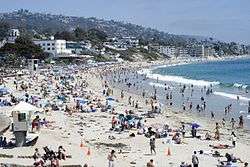
Laguna Beach has a history of environmental stewardship and historic preservation. Laguna Beach is the only Orange County city protected by a dedicated greenbelt inland and bluebelt seaward. In 1968, local conservationists founded Laguna Greenbelt and began a drive to conserve a horseshoe of hills and canyons surrounding Laguna Beach.[63] As of 2011, more than 20,000 contiguous acres of wildlands constituted The Laguna Coast Wilderness Park, Jim Dilley Preserve, Crystal Cove State Park, and the Aliso-Wood Canyons Wilderness Park.[64]
The creation of the 7,000-acre Laguna Coast Wilderness Park as a protected area began in the late 1980s and early 1990s when local artists, activists and politicians rallied to preserve Laguna Canyon. With the environmentally focused Laguna Canyon Project and its photographic mural, "The Tell,"[65] as backdrop and stimulus, Laguna citizens forged a partnership to prevent construction of a 3,200-acre housing project in the canyon. An exhibition on the Laguna Canyon Project, titled "The Canyon Project: Artivism," was held at Laguna Art Museum in 2015-16.,.[66][67] Today the Wilderness Park and Laguna Canyon within it are designated as open space into perpetuity.[38]
The Laguna Beach State Marine Reserve (LBSMR), which extends from Irvine Cove to Treasure Island Beach, was established in 2012, to make most of the coastal area a no-take zone.[68] Docents of the Laguna Ocean Foundation provide monitoring and education at tidepools within the LBSMR.[68] In addition, the 3.2 mile long Crystal Cove State Park abuts the northern border of Laguna Beach.
American Craftsman Bungalows from the early 1900s dot the downtown and South Laguna areas. Between 1980 and 1981, the city conducted the Laguna Beach Historic Survey, a city-wide block-by-block study which noted the location of pre-1940 buildings and determined which had historic significance.[69] 706 homes and structures in Laguna Beach were classified as historically significant.[70]
Laguna Beach is the tenth official Transition Town in the U.S. In February 2007, Laguna's city council unanimously voted to join the U.S. Mayors Climate Initiative, and in April, 2013 became the first Orange County city to request formally that the San Onofre Nuclear Reactor not be restarted after its January 2012 shut down. The Aliso Creek Water Reclamation Facility went into operation in 2014. It removes polluted runoff in Aliso Creek, improves ocean water quality, and creates local recycled water.[71] With a grant from Cal Trans, the city is undertaking a transition plan to implement Complete Streets for all users. A North-South bicycle route with signs and sharrows was completed through town in 2014. Laguna Beach passed a city-wide 'Idaho Stop'[72] for cyclist, a no plastic bag ordinance and a no plastic bottle purchasing policy for its government.
Education
Primary and Secondary
The Laguna Beach Unified School District manages public education for city residents. The district includes one high school (Laguna Beach High School), one middle school (Thurston Middle School), and two elementary schools (El Morro Elementary School and Top of the World Elementary School). One private elementary school, St. Catherine of Siena Parish School, is overseen by the Roman Catholic Diocese of Orange.
Higher education
The Laguna College of Art & Design (LCAD) is a small private college located in Laguna Canyon. It was founded in 1961 by the Festival of Arts and Laguna Art Museum as the Laguna Beach School of Art. LCAD offers bachelor of arts degrees in drawing and painting, illustration, animation, graphic design, and game art, and master of fine arts degrees in painting and drawing. In 2013, enrollment was approximately 450 students.[73]
Notable people
Broadcasting and media
Laguna Beach has its own FM community radio station, KX 93.5.[74] The community is served by two weekly local newspapers: the Laguna Beach Independent and the The Coastline Pilot, a subsidiary of the Los Angeles Times. In 2004, MTV created a reality television show entitled Laguna Beach: The Real Orange County, which aired for three seasons.
Infrastructure
Fire protection in Laguna Beach is provided by the Laguna Beach Fire Department, and law enforcement by the Laguna Beach Police Department. Laguna Beach also has been using goats as part of its fuel reduction and vegetation management program since the early 1990s.[75] Marine safety services are provided jointly by Laguna Beach City Lifeguards in north Laguna Beach and by Orange County Lifeguards in south Laguna Beach.
1993 fire
A fire in Laguna Beach in October 1993 destroyed or damaged 441 homes and burned more than 14,000 acres (5,700 ha). The National Fire Protection Association listed it as the seventh largest-loss wildland fire in the United States.[76]
Sister cities
Laguna Beach has 3 sister cities:
References
- ↑ "California Cities by Incorporation Date" (Word). California Association of Local Agency Formation Commissions. Retrieved August 25, 2014.
- 1 2 "City Profile". City of Laguna Beach. lagunabeach.net. Retrieved 2013-10-07.
- ↑ "2010 Census U.S. Gazetteer Files – Places – California". United States Census Bureau.
- ↑ "Laguna Beach". Geographic Names Information System. United States Geological Survey. Retrieved October 20, 2014.
- 1 2 "Laguna Beach (city) QuickFacts". United States Census Bureau. Retrieved February 16, 2015.
- ↑ Carlton, Carisa (November 18, 2013). "The Giant Aquarium: Laguna Beach State Marine Reserve & Conservation Area". Laguna Beach Gazette. Retrieved November 19, 2013.
- ↑ Turnbull, Karen (2004). "Laguna Beach and South Laguna". In Esther Cramer. A Hundred Years of Yesterdays. II. Orange County Historical Commission. pp. 161–67.
- ↑ McManamon, Francis P.; Cordell, Linda S.; Lightfoot, Kent G.; Milner, George R. (December 2008). "The Earliest Inhabitants and Sites". Archaeology in America: An Encyclopedia. Greenwood Publishing Group. p. 22. ISBN 978-0-313-33184-8.
- ↑ Driscoll, Marjie (Nov 4, 1971). "His 38-Year Affair With 'Laguna Woman'; Amateur Archaeologist Tells Affair With 'Laguna Woman'". Los Angeles Times. p. H4.
- ↑ Pollard, A. Mark; Heron, Carl (2008). Archaeological Chemistry. Royal Society of Chemistry. pp. 281–4. ISBN 978-0-85404-262-3.
- ↑ Chace, Paul G. (1965) "A History of Archaeology in Orange County" Pacific Coast Archaeological Society Quarterly 1(3): 3-23
- ↑ Cameron, Constance. "Determining tribal boundaries through potsherds-an archaeological perspective." Pacific Coast Archaeological Society Quarterly 35.2/3 (1999): 96-126.
- ↑ McManamon, Francis P.; Cordell, Linda S.; Lightfoot, Kent G.; Milner, George R. (December 2008). Archaeology in America: An Encyclopedia. Greenwood Publishing Group. p. 97. ISBN 978-0-313-33184-8.
- ↑ Gudde, Erwin Gustav (1969). California Place Names: The Origin and Etymology of Current Geographical Names (3rd ed.). Berkeley and Los Angeles, California: University of California Press. p. 170.
- 1 2 California Coastal Commission (November 6, 1987). The California Coastal Resource Guide. University of California Press. pp. 324–5. ISBN 9780520061866.
- ↑ Vogel, Claire Marie (March 31, 2009). Laguna Beach. Images of America. Arcadia Publishing. p. 36. ISBN 978-0738569970.
- ↑ Boyd, Michelle (March 31, 2011). "Early Days of a Pioneering Laguna Family". Laguna Beach Independent. Retrieved October 8, 2013.
- ↑ Joseph Smith Thurston, 1947, Laguna Beach of Early Days, Murray & Gee
- ↑ Turnbull, Karen (January 1, 1988). Ester R. Cramer, ed. A Hundred Years of Yesterdays: Centennial History of the People of Orange County & Their Communities. Santa Ana: Orange County Centennial Inc. OCLC 18979450.
- ↑ Armor, Samuel (1921). History of Orange County, California. Los Angeles: Historic Record Company. pp. 478–81.
- ↑ Talber, Thomas B.; MacAuthur, Mildred Yorba; Meadows, Don C. (1963). The Historical Volume and Reference Works: Orange County. Historical Publishers. p. 241.
- ↑ Clemence, Sara (May 23, 2005). "Lavish Laguna Living". Forbes Magazine.
- ↑ Vogel, Claire Marie (March 31, 2009). Laguna Beach. Images of America. Arcadia Publishing. p. 17. ISBN 978-0738569970.
- 1 2 Neisser, JaPatmes (April 12, 1979). "Laguna Beach: Orange County's Eclectic Village". Orange Coast Magazine. 5 (4): 10–16. Retrieved October 8, 2013.
- ↑ "History". About Us. Laguna Art Museum. 2013. Retrieved October 8, 2013.
- ↑ Vogel, Claire Marie (March 31, 2009). "4 Art, Festivals and Films". Laguna Beach. Images of America. Arcadia Publishing. pp. 77–86. ISBN 978-0738569970.
- ↑ Sleeper, Jim (1980). Great movies shot in Orange County that will live forever (or at least until 1934). Trabuco Canyon, CA: California Classics.
- 1 2 3 4 Talber, Thomas B.; MacAuthur, Mildred Yorba; Meadows, Don C. (1963). The Historical Volume and Reference Works: Orange County. Historical Publishers. pp. 249–50.
- ↑ "City of Laguna Beach. Overview". City of Laguna Beach. Retrieved 2009-04-29.
- ↑ Gerry Max, Horizon Chasers: The Lives and Adventures of Richard Halliburton and Paul Mooney (McFarland, 2007), p. 67 and 258n9 for references..
- 1 2 Schou, Jonathan (March 16, 2010). Orange Sunshine: The Brotherhood of Eternal Love and Its Quest to Spread Peace, Love, and Acid to the World. New York: St. Martin's Press. pp. 2–8.
- ↑ Schou, Jonathan (March 16, 2010). Orange Sunshine: The Brotherhood of Eternal Love and Its Quest to Spread Peace, Love, and Acid to the World. New York: St. Martin's Press. p. 69.
- ↑ "Beaches". Visit Laguna Beach. Laguna Beach Visitors Center. Retrieved 2013-11-04.
- ↑ U.S. Geological Survey Geographic Names Information System: Temple Hill
- ↑ Harris, Eleanor (November 2, 2006). Quick Escapes Los Angeles, 7th: 20 Weekend Getaways from the Metro Area. Quick Escapes (7th ed.). GPP Travel. p. 11. ISBN 978-0762742196.
- ↑ Vogel, Claire Marie (March 31, 2009). Laguna Beach. Images of America. Arcadia Publishing. p. 7. ISBN 978-0738569970.
- 1 2 "International Mountain Bicycling Association".
- 1 2 Adam Maya. "Laguna Coast Wilderness Park," Orange County Register, 23 September 2012.
- 1 2 "Historical Sea Surface Temperature for Laguna Beach". Laguna Beach Water Temperature and Wetsuit Guide (Orange County, USA). surf-forecast.com. 2013. Retrieved 25 October 2014.
- ↑ "Monthly Averages for Laguna Beach, CA". The Weather Channel. Retrieved 2010-11-28.
- ↑ "Annual Estimates of the Resident Population for Incorporated Places: April 1, 2010 to July 1, 2015". Retrieved July 2, 2016.
- ↑ "Census of Population and Housing". Census.gov. Retrieved June 4, 2015.
- ↑ "2010 Census Interactive Population Search: CA - Laguna Beach city". U.S. Census Bureau. Retrieved July 12, 2014.
- 1 2 "Laguna Beach (city), California". Quick Facts. United States Census Bureau. June 27, 2013. Retrieved 2013-12-18.
- ↑ "American FactFinder". United States Census Bureau. Retrieved 2008-01-31.
- ↑ "American FactFinder". United States Census Bureau. Retrieved 2008-01-31.
- ↑ American FactFinder, United States Census Bureau
- ↑ Vogel, Claire Marie (2009). Images of Laguna Beach. Arcadia Publishing. p. 100. ISBN 978-0-7385-6997-0.
- ↑ Change, Richard (June 27, 2010). "Summer is Festival Time". The Orange County Register. p. Arts & Entertainment 3. Retrieved June 28, 2010.
- ↑ Clay, Joanna (June 24, 2011). "Connection through Art-A-Fair". Laguna Beach Coastline Pilot. Retrieved October 9, 2013.
- ↑ Allard, Maurice (July 1989). "Spotlight: Laguna Beach". Orange Coast Magazine. 15 (7): 22–24. Retrieved August 28, 2013.
- ↑ Laguna Plein Air Painters Association — 15th Annual Laguna Beach Plein Air Painting Invitational
- ↑ "Kelpfest 2014".
- ↑ Warshaw, Matt; Finegan, William (November 7, 2005). The Encyclopedia of Surfing. Mariner Books. p. 86. ISBN 9780156032513.
- ↑ Kane, Rich (June 10, 2013). "Brooks Street Surf Classic Finally Happens After a Two-Summer Wait". Laguna Beach Patch. Retrieved April 1, 2014.
- ↑ Connelly, Laylan. "Best skimboarders in the world to hit Laguna Beach". Orange County Register.
- ↑ "Hall of Fame Inductees". Archived from the original on July 6, 2014.
- ↑ "US Open 2014"..
- ↑ "City Clerk". Laguna Beach, CA. Retrieved January 13, 2015.
- ↑ "City Treasurer". Laguna Beach, CA. Retrieved January 13, 2015.
- ↑ "County, State, and Federal Representatives". City of Laguna Beach. Retrieved November 10, 2012.
- ↑ "California's 48th Congressional District - Representatives & District Map". Civic Impulse, LLC.
- ↑ Fetherling, Dale (September 19, 1976). "Laguna Greenbelt: An Idea That Became a Crusade". Los Angeles Times. p. OC1.
- ↑ "Laguna Greenbelt History". About. Lagunagreenbelt.org. 2011. Retrieved October 6, 2013.
- ↑ Cathy Curtis. "The Tell Does Indeed Deliver Its Message of Protest," Los Angeles Times, 21 August 1989.
- ↑ Dave Barton. "Laguna Art Museum exhibit celebrates the city's defining feature—no, it's not the beach” OC Weekly, 29 October 2015.
- ↑ Antoine Boessenkool. "New exhibit in Laguna recalls 'The Canyon Project'” Orange County Register, 17 October 2015.
- 1 2 Reckas, Ted (December 30, 2011). "New Ocean Protections Come Ashore". Laguna Beach Independent. Retrieved October 6, 2013.
- ↑ UC Irvine Special Collections. "Guide to the Laguna Beach Historic Survey Board Records, 1980-1981".
- ↑ Rollinger, Verna; Laguna Beach City Council (December 21, 1982). "Laguna Beach Historic Resources Survey". Lagunabeachcity.net. Retrieved October 6, 2013.
- ↑ Laguna Beach Water Project
- ↑ Idaho stop
- ↑ "Laguna College of Art and Design". Colleges. U.S. News & World Report. 2013. Retrieved October 9, 2013.
- ↑ Laguna's Only FM Radio Station Retrieved Sept.30, 2014
- ↑ FEMA: Mitigation Best Practices Portfolio
- ↑ "Remembering the Day Laguna Beach Burned". The Orange County Register. October 27, 2013. p. News 1.
External links
- Official website
- Laguna Beach Visitors & Conference Bureau - Tourism
 Media related to Laguna Beach, California at Wikimedia Commons
Media related to Laguna Beach, California at Wikimedia Commons
 |
Newport Beach-Newport Coast | Laguna Coast Wilderness Park | Aliso Viejo & Laguna Woods |  |
| Pacific Ocean | |
Laguna Niguel | ||
| ||||
| | ||||
| Pacific Ocean | Dana Point | Laguna Niguel |
